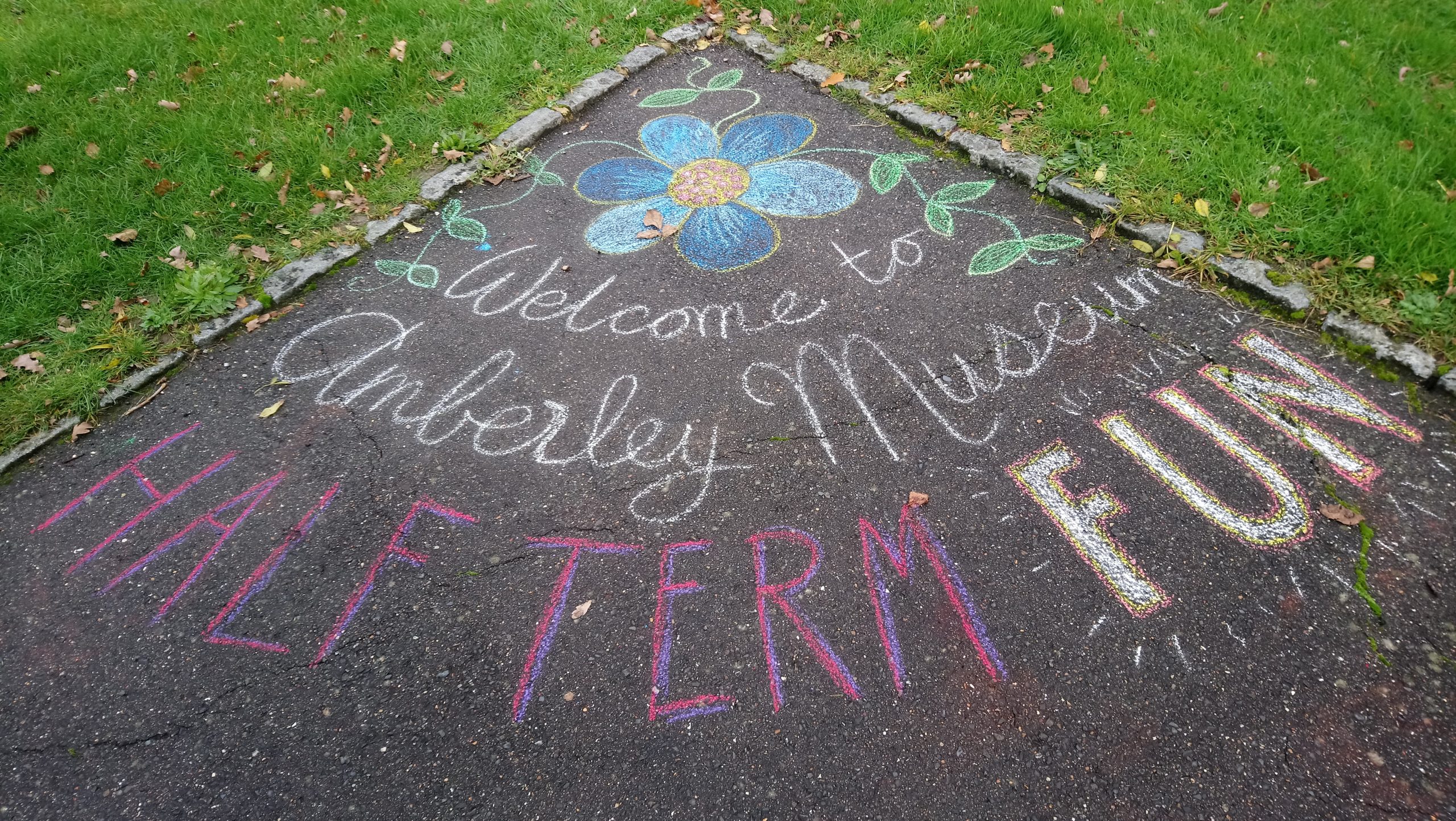What was your play pilot?
When visualising how free play could enhance families’ experience of our site, I immediately thought about utilising the long tarmacked and concrete roadways that link the numbered attractions on our site map. In normal times, buses (sometimes vintage) trundle up and down these, transporting people and bringing that space excitement and purpose. Now, visitors have to walk. How could we turn journeying through these spaces from (at worst) a chore into an integral part of the museum experience?
I’d created some simple chalking spaces and play prompts when we’d reopened after the first lockdown (mid-July 2020) and liked the simple, non-prescriptive self-expression it encouraged. So I decided to try something bigger that could potentially connect the whole site: first child-sized train tracks and roadways, then a variety of journeying-inspired prompts – wiggly lines, brick road, mazes, giant robin footprints – at surprising points around the museum.
Children could play around these and/or add to them: we provided a small envelope with one white and one coloured chalk per child. I had no specific age range in mind, and was above all curious about who would participate and what would arise. We were held back by several factors: a thoroughly rained out half term and much of my energies during that week being ploughed into running a separate Kids in Museums trail and managing a new team of volunteers.
Time to observe, record and evaluate was thus limited, but I still feel that the experiment was worthwhile. It’s given me the space to start envisaging on a much broader scale how we could redesign our wayfinding, interpretation and infrastructure to be more playful and functional for families, and my colleagues, although not directly involved with this project, are more interested in that vision as a result.
Budget
£
What would you consider your level of experience in creating playful interventions in museums prior to the project (1 being the least experienced and 5 being the most)?
2
Why did your organisation choose to do take part?
We are at a point where we are re-evaluating what our museum offers to families. While COVID-19 forced us to decommission many popular interactives, we’ve also had a fairly recent change in leadership and learning personnel. This project seemed an ideal way to draw on the expertise of play experts and the experiences of other organisations thinking along similar lines.
What did you achieve?
Personally, more confidence to advocate for play and other aspects of community engagement I believe to be important, through both words, actions and relationship building.
Another museum is possible: I think it was useful for all stakeholders to witness new potential in what has traditionally been a collections-focused site.
Visitors have been able to linger around shared activities and add to the museum narrative, albeit briefly. Chalking in the summer holidays as lockdown eased appeared particularly cathartic. I feel satisfied that we have been able to respond to visitors’ needs in this way.
This pilot can now act as a springboard for strategic discussions about the place of play in our museum.
Lessons learnt
Involve your team: It felt difficult to do in my case because our staff are all stretched but communicating better with front of house and marketing to better promote what I was doing on and off-site might have promoted uptake.
Understand your site: Our open-air exhibits and green spaces already ‘allow’ for a playful disposition. There is also a huge amount to see and do, and volunteers to talk to. So it doesn’t really make sense to judge a success by how many people have left drawings on the tarmac, which is what I initially was looking for. As Penny and Charlotte say, the outcome of play is play! So longer-term evaluation would need to be more observational and draw on specific visitor feedback.
Communicate accordingly: I was hoping that people would instinctively get involved as soon as they saw chalk and prompts but a lot of visitors seemed a bit bemused or indifferent to what was going on. A critical mass of participation might have helped ‘sell’ the activity and ‘given permission’ to those less uninhibited, and this in itself would have benefitted from consistent communication with visitors.
Plan for all weathers: It sounds obvious, but think what to do if rain literally stops play! You can adapt to an extent (‘Welcome to Puddleland!’) but know when to move to Plan B or cut your losses.
Top tips
Don’t be afraid to try something a bit unusual: just start small and inexpensive and see how the ideas flow and grow as people are added to the mix. No one can be expected to get things spot-on without testing, so equally don’t feel disheartened if your experiments don’t ‘work’ as you’d planned: it’s all useful.
Play is hard to define or predict so definitely think near the beginning of your journey about how you will evaluate, starting with ‘what’ you want to measure before ‘how’.
The Play in Museums in a Socially Distanced World project was made possible by the National Lottery Heritage Fund.
Categories: Play
Audience: Family

